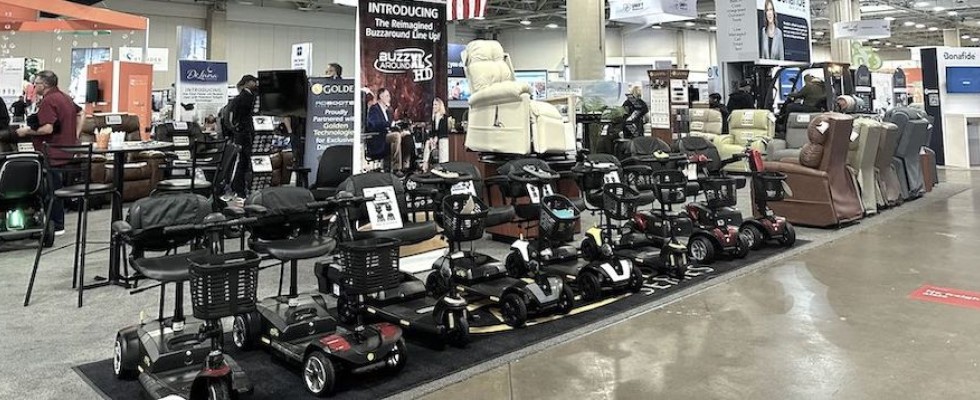
Portability and fun.
Those were the key words for new and popular mobility products on display at Medtrade, the largest showcase for home medical equipment (HME).
From booth to booth on the show floor in Dallas in March, company representatives and the HME providers in attendance raved about mobility items—especially scooters, wheelchairs and rollators—that are getting lighter, easier to fold or break down to fit in a small vehicle, and more fun to use.
On the “fun” side, Journey Health and Lifestyle showed off its new ComfyWheels three-wheeled scooter in the New Product Pavilion. Built like a stand-up electric scooter with the added stability of a wide bicycle-style seat, the personal electric vehicle goes up to 25 miles on a charge and hits speeds up to 15 miles per hour.
The company also had its Journey Adventure Scooter--which disassembles into five small pieces, the heaviest of which is 33 pounds—and its Journey Air Elite, a power wheelchair that tops out at 29 pounds with the battery in (26 pounds without).
“Weight is the biggest issue,” said Brian Smith, territory sales manager for Journey. But looks also matter, he said. “You see a lot of these chairs that don’t look medical—most people don’t want to admit they need help.”
Jaden Kincheloe, a Medtrade attendee who works as a technician for Mobility City, an HME provider in Plano, Texas, said customers are looking for equipment that is "lightweight, foldable, and something they can fit on an airplane."
The SEATA rollator from Strongback Mobility also focuses on the fun, with bright colorways and a sleek design. The device has a comfortable seat and back and is adjustable to fit users ranging from 5’2” to 6’4”. An entry in the New Product Pavilion, the SEATA had already sold out its first container, said Drew Calhoun, DME sales manager. Strongback was seeing interest in its 22-inch-wide bariatric chair, which carries up to 375 pounds and weighs in at just below 36 pounds—less than the usual 50-pound weight typical for bariatric products.
Bright colors are definitely a new trend, said Rachel Chang, marketing director, for Reyhee Group, which offers its new devices in colors including red, blue, bright purple and electric green. The company—which owns an overseas factory that previously produced products for other companies and recently decided to create some independently—showed off its Triad three-wheeled scooter in the New Product Pavilion.
“People don’t really want the gray or black anymore,” she said.
The Golden Ally electric wheelchair is the company’s take on a blend of portability and fashion, with a weight of 50 pounds, easy foldability to fit in a small trunk, and a weight capacity of 330 pounds. It also has high-design touches like leather arms, a glowing green battery light, hard carry case and a USB-C charger.
“We like to think of it as the Tesla of foldables,” said C.J. Copley, executive vice president of sales and marketing for Golden. As an added technology boost, the chair can be driven with a phone—making it easier for a caregiver or family member to manage, or giving a user the ability to store it away from the bedside and retrieve it easily.
Golden’s updated Cricket foldable power chair is 100% carbon fiber and easy to fold at 33 pounds. And the company is also seeing interest in the CarryOn Wheelchair, a new addition to the CarryOn family that’s designed to fold flat (below 10 inches) to fit under a cruise ship bed.
Pride Mobility launched its new Go Go Elite Traveller 2, a four-wheel addition to the Go Go scooter line, which claims the tightest turning radius of any four-wheel scooter on the market. It separates into five pieces and comes in matte colors like robin’s egg blue, yellow, plum and tangerine.
There are a few exceptions to the smaller-is-better rule, and one is Pride’s Baja line, which showed off new accessories including a full-height windscreen, making it feel more like a recreational vehicle or golf cart than a mobility device. On the Quantum line, the company showcased a prototype of its Outback 4x4, which should launch in the fall of 2024.
Another larger model is Drive’s Cobra GT4—a relaunch of its popular Cobra line that paused during and immediately after the public health emergency when the company had to focus on other products amid supply chain disruptions. Cobra is a heavy-duty all-terrain scooter with a travel range of 35 miles, a seven-inch ground clearance and the ability to handle an eight-degree incline, allowing it to take on curbs. It has a fully adjustable tiller for large riders and can carry 450 pounds—but it does require a heavy vehicle to carry and a lift.
Drive is also bringing back its Panther heavy-duty scooter, its Phoenix line and the Scout and Ventura portable scooters. And it introduced the new Nitro Glide knee walker and showed off the Nitro three-wheel scooter, both in a sleek design and bright colors.
One company, Feather, has gone all-in on the idea of portability, focusing on making the world’s lightest mobility equipment. At Medtrade, it showed off its new Featherweight Folding Mobility Scooter, which weighs 27 pounds without its battery (about 30 pounds with it) and folds down to under two feet long—so small that it can fit in the overhead compartment of a commercial airplane. It’s a 10-pound improvement over the previous model, which weighed 37 pounds, said Joseph Piekarski, CEO and founder.
“This is what we’re really super excited about,” Piekarski said. “We design for aging-in-place for an older person who’s traveling and wants to get out there. The magic happens when you lift it in and out of a car.”
